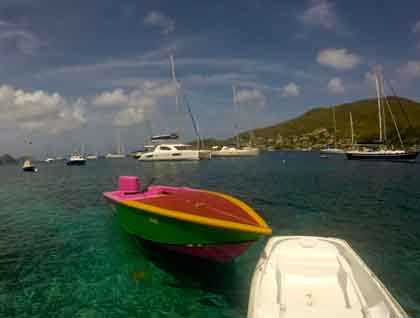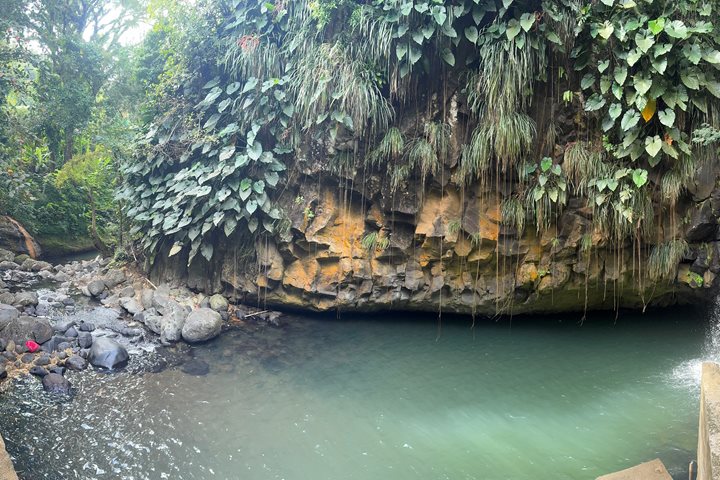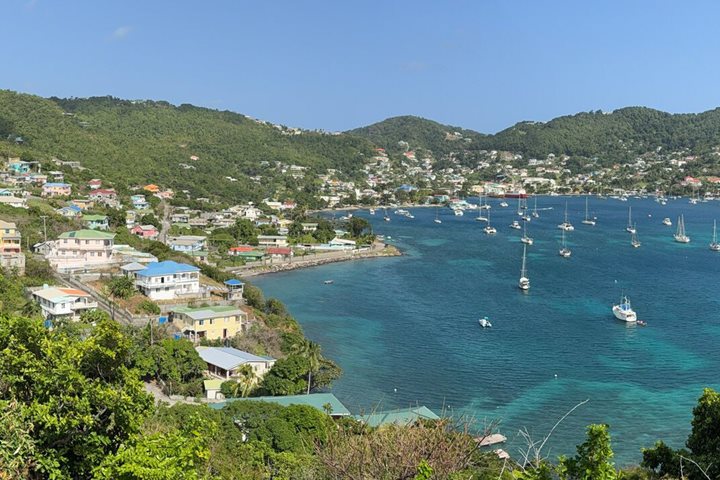We motored into the beautiful Admiralty Bay by 6:15 a.m. The morning clouds hung low in the sky but by breakfast time they had burned off and a beautiful azure sky hung high overhead. We boarded tenders for the small village of Port Elizabeth and there split into two groups and boarded the small pick up trucks for our visit to this enchanted isle.
Bequia is different than many of the other islands we visited as among its earliest European settlers were a large number of indentured servants from Scotland, Wales, Ireland, and England. Their heritage is evident in their faces. Of course as with all the other islands there is a majority African-American population on the island. These original settlers who emigrated up from the Orinoco basin centuries earlier had already begun to mix with the African population also brought to work the sugar plantations. The largest of these plantations were located on the east side of the island, near Industry Bay that we visited. The people who resulted from this Caribe/African mix were called “Garafuna,” or sometimes “Black Caribe.” I cannot testify to my following etymology but it sounds to me as if the word “Garafuna” may be a dialect expression of “Caribe-fumé” with “fume” suggesting the darkening of the skin when the races mixed.
Our first visit was to Fort Hamilton, named after Alexander Hamilton whose father was from Nevis and an important individual in these islands. Once we got settled on this promontory lookout our three guides regaled us with local lore and sang a number of traditional Becquian songs. The one “Blow, Blow, Blow” records the whaling history planted on these islands in the 19th century by New Bedford whalers.
Our next stop was to Brother Orton King’s Turtle Sanctuary. Brother King is a reformed Hawksbill Turtle fisherman who has dedicated the last 20 years of his life to breeding and releasing Hawksbill turtles. He has now returned 920 5-year-old turtles to the sea and this year he expects to see his first returning mature adults returning to breed. School groups visit and he hopes this program will teach the locals to protect their sacred marine heritage instead of pillaging it. My hopes go with him.
We then returned to the capital of Bequia, Port Elizabeth, and dispersed to the winds, if such a phrase makes sense in a village about ten blocks long! The merchants has set up small kiosks where every sort of merchandise was for sale from Rastas selling fresh fruit and veggies, to fisherman selling whale scrimshaw, and handmade bracelets fashioned from volcanic soil and local hard woods. Most of us were drawn irresistability to “Jacks.” This fabulous and famous watering hole serves delicious food and the most refreshing tropical drinks of every variety. Lindblad Expeditions treated us all to a complementary drink. We had mojitos, BBC’s, rum punches, and anything that works well with rum and fresh fruit! The beach in front of Jacks is excellent for swimming and most of us took a cooling dip before returning to the Sea Cloud for the justifiable famous Parmesan pasta lunch.
Fresh cooked pasta is ladled into the middle of a 150-pound wheel of Parmesan and the cheese is then scraped from the side and is tossed with your pasta. Scrumptious. I saw many, many seconds. Simon, our indispensible and unforgettable Hotel Manager, purchased a freshly caught 75-pound yellow fin tuna and we had that with the pasta. Cocktails and the festivities for our last night together were on the lido deck beginning at 6:00p.m. Mike Greenfelder put the guests’ photos into a photographic log and it looped continually on the large HD TV on the lido deck. I find these last nights both festive and slightly sad as we have made so many new friends and now must say goodbye. We should rather say until we sail again and keep a fresh wind at your back.









